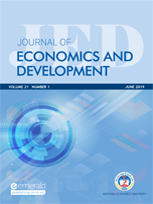Confucianism, growth and democracy
Keywords:
Confucianism, Growth, Democracy, Two-regime panel threshold model
Abstract
PurposeThe purpose of this article is to investigate the impact of Confucianism on growth under different political regimes.
Design/methodology/approach
The empirical specification adopts a two-regime panel threshold model proposed by Hansen (1999) to endogenously divide our country sample into two-regime-types – autocracy and democracy – according to a country's democratic stock or experiences.
Findings
The results show that the effect of Confucianism on growth exhibits an asymmetrical pattern depending on the status of a country's political democracy. Only when a moderate level of freedom has already been attained can Confucianism have a positive effect on growth. Conversely, for autocracies whose democratic institutions cannot pass a certain threshold, Confucianism has a very limited effect in terms of changing economic activity.
Research limitations/implications
If the data with different sample years and/or different sample countries are used, the research results may lack generalizability. Further tests of the two-regime model with different data sizes are encouraged.
Originality/value
The authors use the World Values Survey (WVS) map to identify the countries under the influence of Confucianism. The authors emphasize that focusing only on political geography may overlook the information from the spread of cultural traits that accompanied the migration of people. So, based on the Confucian countries suggested by the WVS and the migration matrix of Putterman and Weil (2010), an immigration-based Confucianism variable was constructed. To accommodate different effects of Confucianism on growth in different phases of political development, the empirical specification adopts an asymmetrical pattern to investigate the impact of Confucianism on economic performance.

